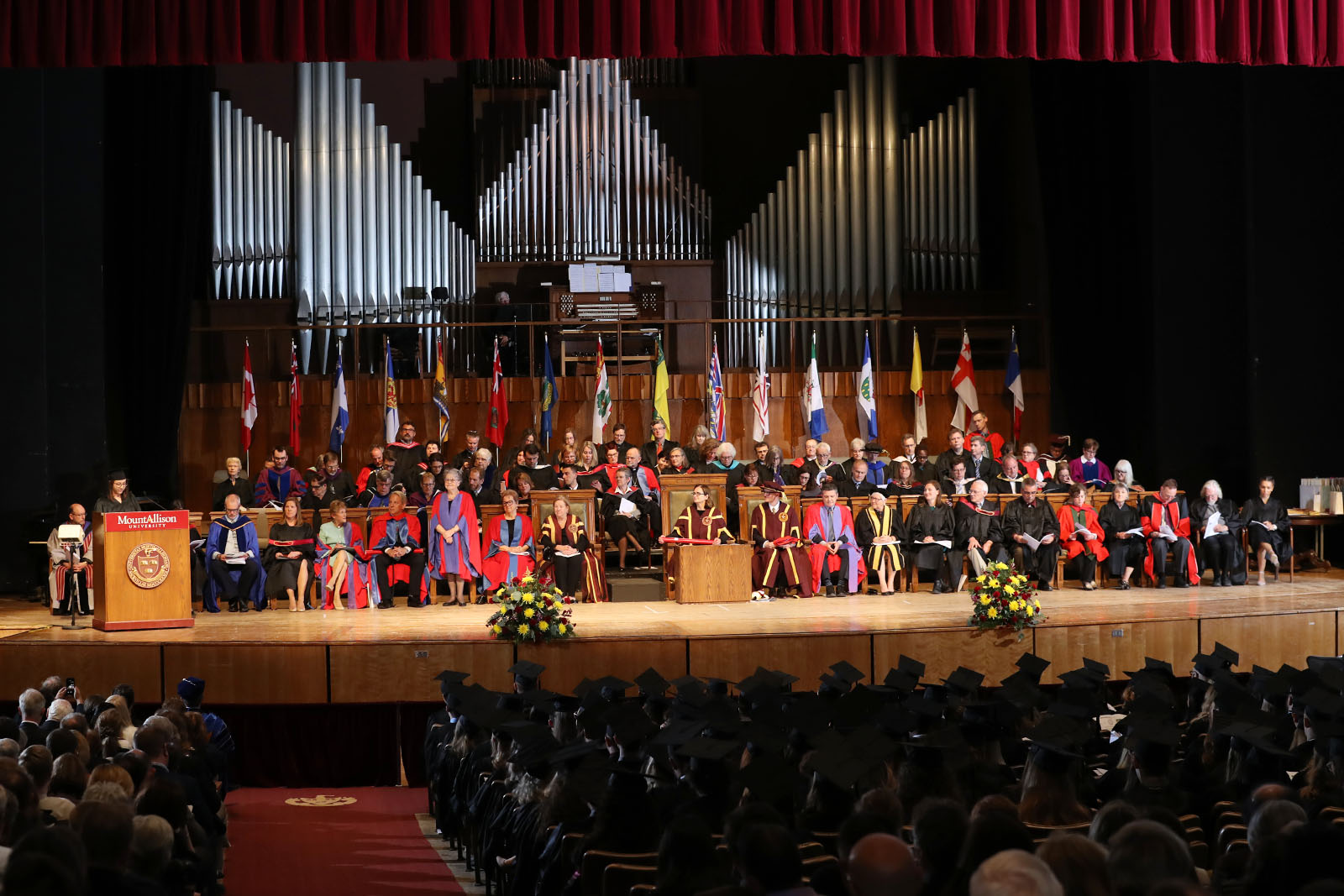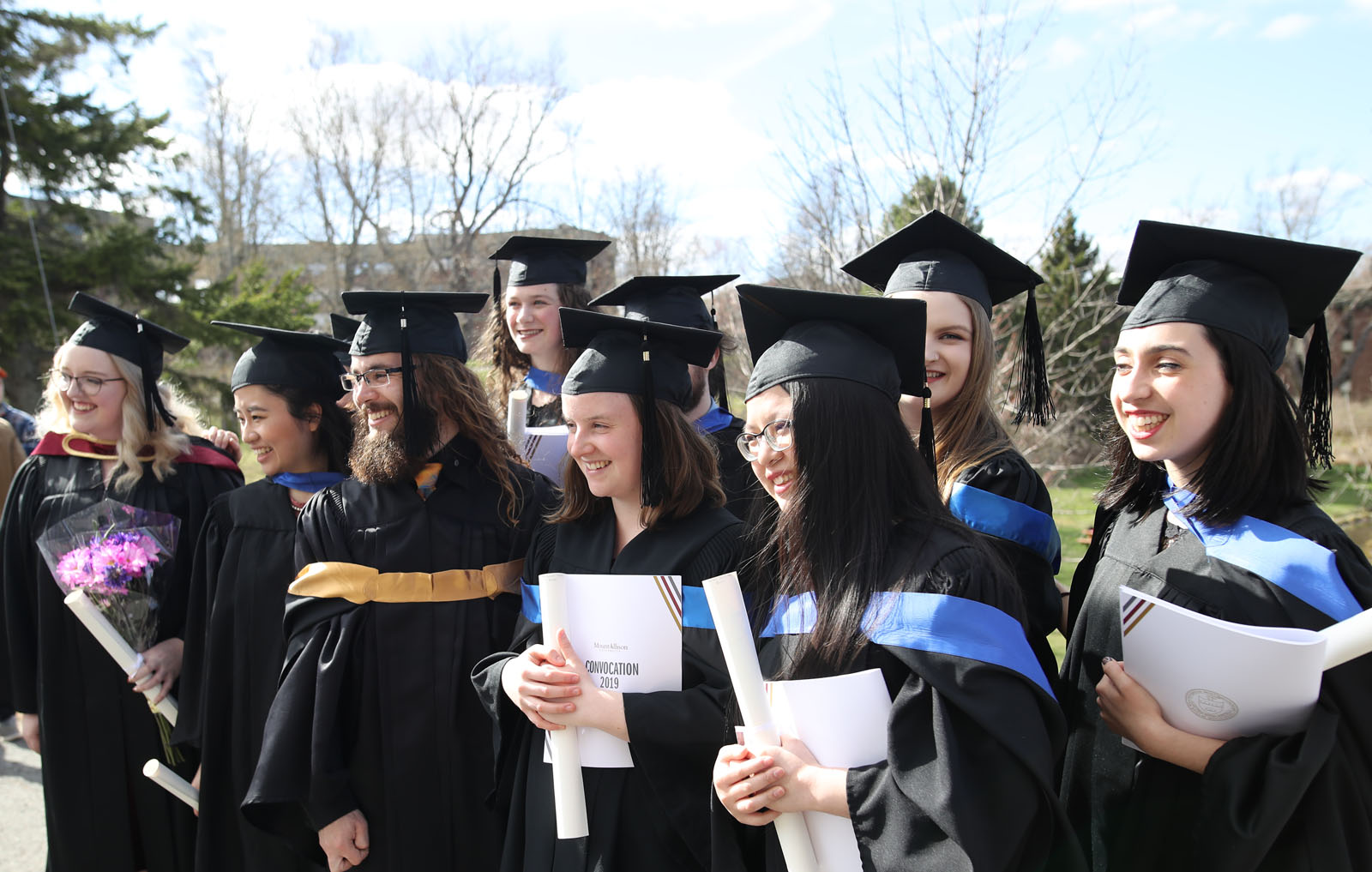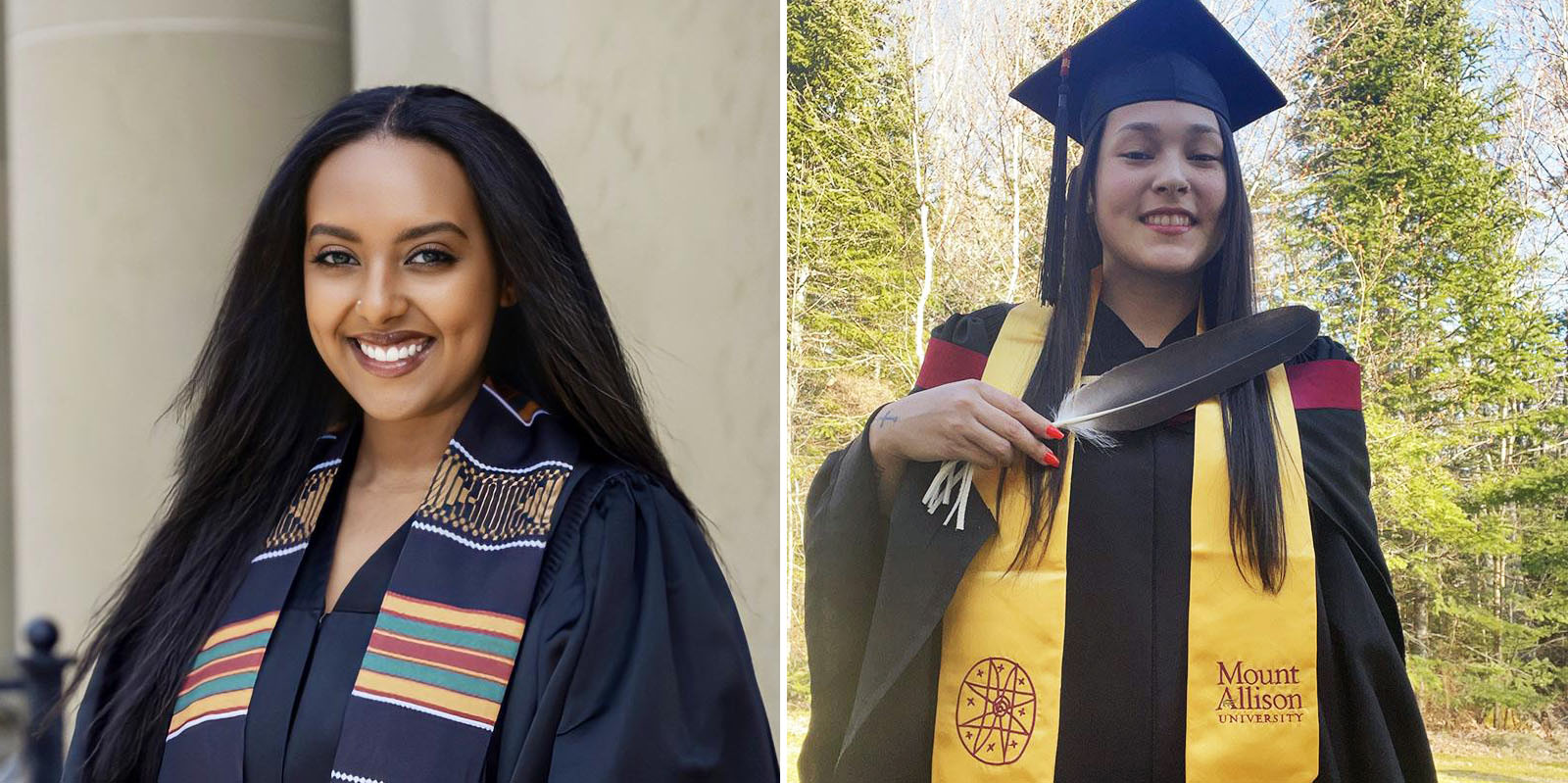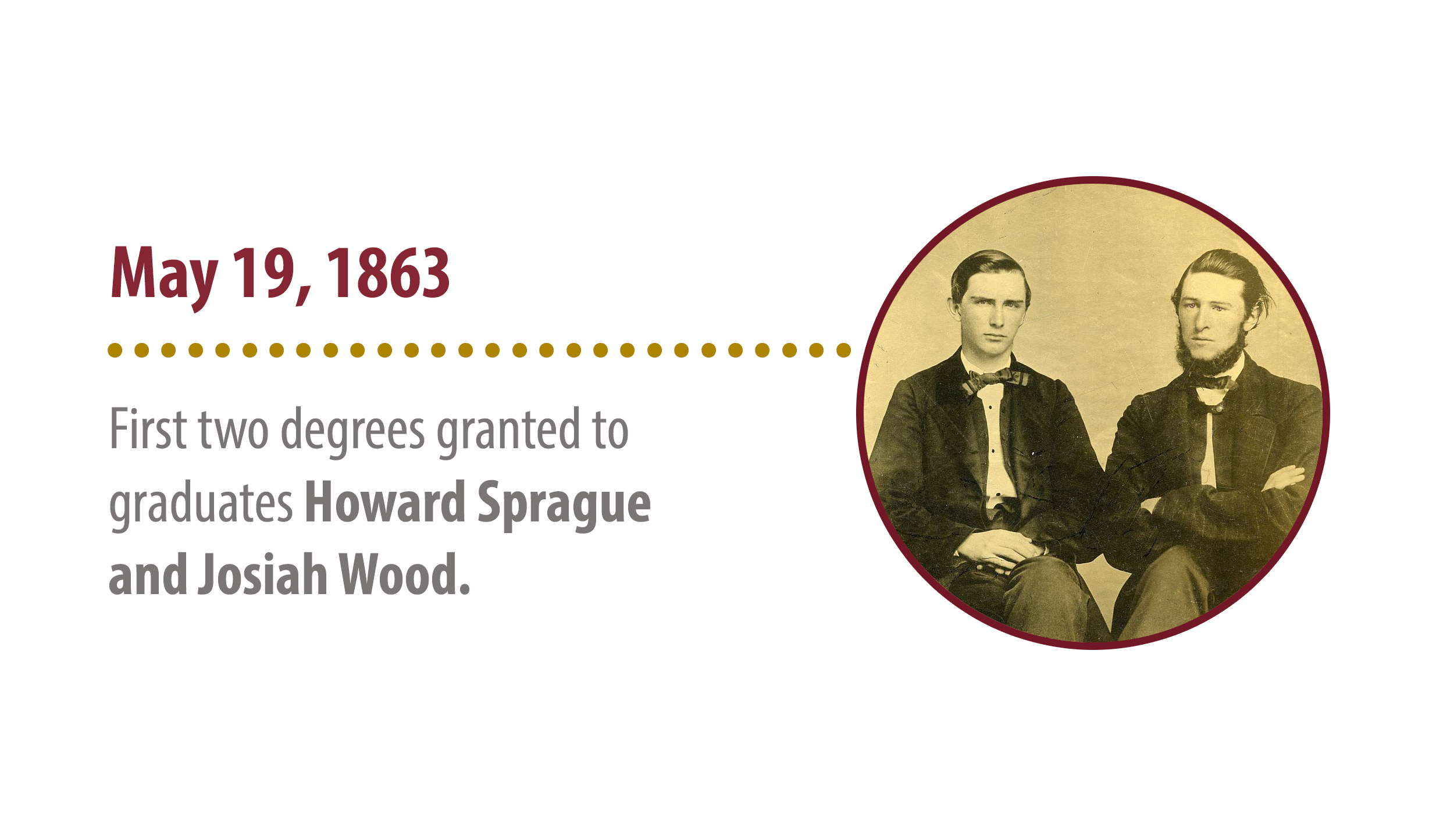
Convocation procession and degrees
Mount Allison University prides itself on the quality and personal nature of its Convocation.
It is rightly a colourful occasion filled with music and pageantry in celebration of your achievement. Because there will not be an opportunity to rehearse the ceremony with the graduating students, it will be helpful if you take the time to acquaint yourself with the logistical details of the procession and degree granting process.
| Don't worry! On Convocation Day there will be a number of marshals available to direct you. |
Student procession on Convocation Day
On Convocation Day, the student procession, which forms in the PCCA one hour before the ceremony*, is marshaled according to degrees and in order of classes of degree, e.g. BA with First Class honours with distinction, First Class Honours, Honours with distinction, Honours, BA with distinction, BA, etc.
Students therefore need to be ordered in this way for seating so that they can move to the stage for presentation according to this pattern.
Don't worry! On Convocation Day there will be a number of marshals available to direct you.
TIPS TO HELP MAKE THIS PROCESS GO SMOOTHLY:
- It will take time to organize graduates. Please be on hand at the PCCA no later than one hour before your ceremony.
- Have your cap, gown, hood (folded) with you. October grads should wear their hood.
- Upon entering the PCCA, please pick up a copy of the Convocation program. This will help you identify your place in the seating order. The parade marshals will organize you there and your attention will be appreciated.
- If you have a name that is commonly mispronounced, please see the secretary of Senate to ensure that they are informed of the correct pronunciation.
Fifteen minutes before the start of the ceremony, the procession will depart from the PCCA for Convocation Hall in a double line ordered alphabetically by class of degree. During the procession, carry your hood over your left arm with the colour tab up and wear your mortarboard with the tassels on the right.
The student procession will be preceded by the faculty procession which departs from the Chapel. When the platform party reaches the steps of Convocation Hall, it will part to form a passage for graduates to walk through, moving into the foyer and into the hall to be seated at the direction of the marshals.
The double file student line will consist of pairs of students; the surname of the person in the left-hand position being higher in the alphabet. It is essential that pairs remain in the proper order throughout the procession. This line will enter the hall by the right-hand aisle, and be seated in the centre section of the hall from the front row. As the procession reaches a row, the left-hand person enters first, followed by the right-hand person, and so on. The marshals will make sure that 14 persons enter each row. Please move quickly to your seat and remain standing until the platform party is on stage and you are directed to sit.
In the event of inclement weather, the procession will be formed in the basement of Convocation Hall. Notices to this effect will be posted at the PCCA.
Conferring of degrees — step by step
When it is time for the conferring of degrees, the marshal will signal for the first row (marshals will collect each row in turn) to rise together, exiting via the left-hand aisle and approaching the north stairs of the stage.
At this point graduates should have their mortarboard in their left hand and their hood folded with the colour tab facing up on their left arm. You will be handed your name card at the foot of the stairs.
When directed, the first person in the row will move onto the stage, hand the name card to the secretary of Senate, and move two or three steps past them to the line of black tape on the floor. (This is important as it allows the flow of graduands to proceed more quickly across the stage.)
Then simply follow these steps:
- At the line, hold your hood over your left arm and your mortarboard in your left hand.
- As your name is read out, walk towards the Dean.
- Give your hood to the Dean, turn your back to them, and stand close to the platform they're standing on so they can reach to put your hood over your head.
- Turn to your left and stand in front of the Chancellor.
- Place your right hand in the Chancellor's as your degree is conferred.
- When this is completed you will turn and walk toward the President who will shake your hand. Then you will put your mortarboard back on and move the tassel to the left before you proceed the rest of the way across the stage.
- If you do not want to shake hands, please put your right hand on your left chest as you approach the Chancellor and/or President, and nod your head as a greeting.
- Before exiting the stage, you will receive your diploma from the registrar. Indigenous graduates will also receive an eagle feather at this time. After descending the stairs you will return to your seat.
When you re-enter the vacant row of seats, you may not return to the exact seat you had. This is because students who are receiving a second degree will not be returning directly. Rather they will proceed to the back of the hall and assemble on the north wall at the foot of the stage until it is time to return to the stage to receive their next award.
At the conclusion of Convocation, the people on the stage leave first and then the graduates follow on each side, two rows at a time. The marshals will usher your row out of the hall in order from the front row using both aisles. Please move directly out of the foyer and on to the driveway to allow the hall to vacate.
October graduates, second degrees, and certificates — if you are an October graduate, you should wear your hood throughout the day’s ceremonies beginning at the procession.
About our academic regalia

The students and all of the scholars taking part in the ceremony wear what is called academic costume for the event.
The costume consists of a gown — usually made of black silk — and a cap, traditionally the so-called ‘mortarboard’, or alternatively the Canterbury cap. These articles of clothing are relics of the medieval roots of the modern university.
THE GOWN preserves the standard form of dress worn by scholars from the 13th to the 16th centuries — the time when the first European universities were emerging as definable entities. Similarly the scholar’s cap is a legacy of the time when many different occupations were recognized by the hat or costume of their practitioner.
THE HOOD is of special interest for it also derives from a form of clothing. The cut of the hood, if viewed carefully, will show that it is similar to the hood of a parka; it can be draped over the head or allowed to fall loosely over one’s back as is commonly done with the academic hood. This garment was also a standard article of clothing during medieval times. Universities in the British academic tradition, which dates to the mid 13th-century when Corpus Christi College, Cambridge, and University College, Oxford, were founded, have used the hood as a means to distinguish the degrees of their graduates from those at other institutions. This is accomplished by lining the hood with coloured silk or trimming the edge of the hood with fur or coloured silk.
Hoods:
- Arts — edged with garnet and silk with front loop bordered with gold silk
- Science — edged with old gold silk
- Arts and Science — edged with salmon silk
- Commerce — edged with light grey silk
- Music — edged with royal blue silk
- Fine Arts — edged with green silk and orange ornamentation
Stoles:
- For Indigenous students — Mi'kmaw graduation stole embroidered with the Mi’kmaw eight-point star
- For Black students: Kente graduation stole with red, yellow, and green accents
STOLES — In 2022, Kente and Mi’kmaw graduation stoles were introduced for Black and Indigenous students respectively. The Kente stoles have three colours: red represents the blood of Black ancestors, yellow symbolizes strength, and green stands for growth. The Mi’kmaw stoles are embroidered with the Mi’kmaw eight-point star.

—
More advanced degrees typically produce richer and more complex costumes. Thus the doctoral gown is often coloured whereas bachelor gowns are austere black. The varieties of these designs give the academic gathering a colourful and dramatic flavour and add to the spectacle of the event.
The ritual is completed when the student is presented with the scroll indicating the awarding of the degree. In medieval times the scroll was a license to teach, but today the degree acts as a broader accreditation of academic achievement. Upon being ‘hooded’ and receiving the scroll, the student is admitted to the degree and becomes a graduate of the University.
About our diplomas
For more than 35 years, visual artist and former Fine Arts department head Thaddeus Holownia has been printing Mount Allison’s diplomas.
The tradition of hand printing Mount Allison’s diplomas dates back to the early 1900s. Holownia prints the diplomas using the letterpress process at the Anchorage Press in Jolicure, New Brunswick.
Each of the names of Mount Allison’s graduates is hand cast and printed with an embossed method on the diplomas. Each spring he spends considerable time casting all the names of the graduates before printing the diplomas for Convocation.
“The two colours of ink and the scale contributes to the special presence the Mount Allison diploma has on the wall,” he says. “Each one has a real relationship to the history of degree granting at Mount Allison University.”
Diploma frames especially designed for Mount Allison graduates, emblazoned with the University crest, are also available for purchase.

The history of Convocation
Josiah Wood and Howard Sprague could hardly have imagined the foundation they were laying when they accepted Mount Allison’s first two Bachelor degrees in 1863.
The two young men made up Mount Allison’s entire first graduating class.
In the early years the exercises consisted of a series of orations — in English, French, Greek, and Latin — by members of the freshman and junior classes, as well as by each graduating student.
- In 1866, honorary degrees were introduced.
- In the early 1880s, the valedictory address became part of the program, one of the first delivered by William Morley Tweedie, for whom Tweedie Hall is named.
- In 1948, the beloved Alma Mater Song, penned in 1904 by Winthrop P. Bell (1904), became part of the ceremony.
- The 50th anniversary of Convocation saw 26 graduates receive their degrees, while at the 100th anniversary there were about 200.
- In May 2013, approximately 500 graduates followed the path Wood and Sprague forged, receiving their degrees during the University’s 150th Convocation ceremony and adding their names to a roster of about 35,000 others who have earned a degree at Mount Allison.

